Go to Portugal bird tour page | European bird tours | European trip reports | All our birding tours
18 – 28 October 2021
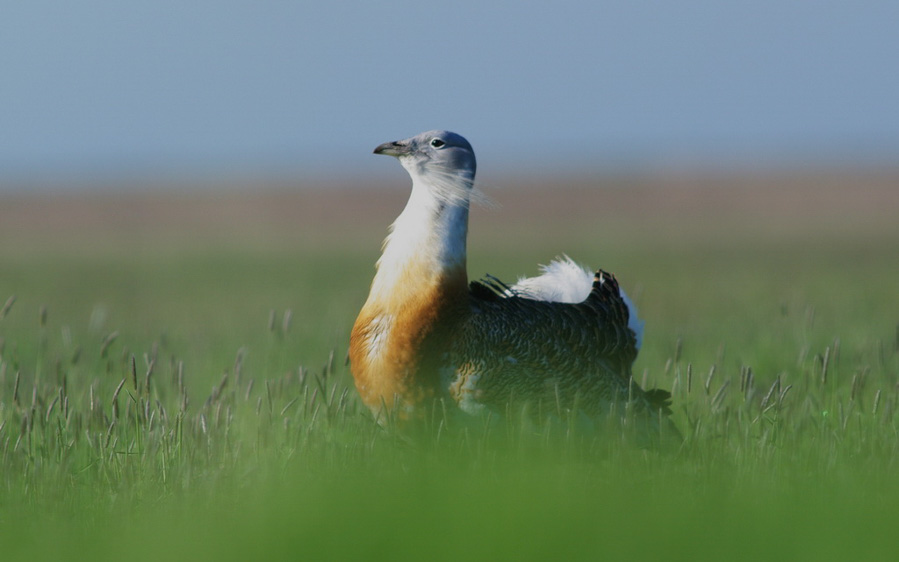
Overview
Our 10-day private tour of Portugal began on the 18th of October 2021, in the ancient city of Porto, and concluded on the 28th of October 2021 in the capital of Lisbon. During the tour we visited many wonderful birding locations including the Douro Valley, Cuba, Mourão, Castro Verde, several sites on the Algarve, and the Tagus Estuary.
This tour was put together as a private adventure for five friends: Urban, Nancy, Sandra, John, and Judy, and is based on our new Portugal set departure tour of the same name where we focus on the birds of the region along with several wine tasting sessions and cultural site visits. We run this tour in partnership with Sociedade Portuguesa para o Estudo das Aves (SPEA) (Portuguese Society for the Study of Birds), BirdLife International’s partner in Portugal, and we are pleased to work with this valuable bird conservation Non-Governmental Organization (NGO). I would like to extend a personal thanks to Lara of SPEA for all her hard work in making this tour the great success it was.
Our trip around this beautiful country gave us many exciting species, including Great Bustard, Spanish Imperial Eagle, Bonelli’s Eagle, Black-bellied Sandgrouse, Audouin’s Gull, Black Stork, Griffon Vulture, Iberian Grey Shrike, Iberian Magpie, Calandra Lark, Bluethroat, and Ferruginous Duck.
A total of 145 bird species were recorded during the tour (three of these were “heard only”), along with a few other interesting animals, including European Pond Turtle, Granada (Iberian) Hare, European Rabbit, Red Fox, and European Fiddler Crab. Species lists are at the end of this report. We enjoyed wine tasting at five gorgeous vineyards, visited numerous impressive cultural sites, and soaked in some staggering landscapes.
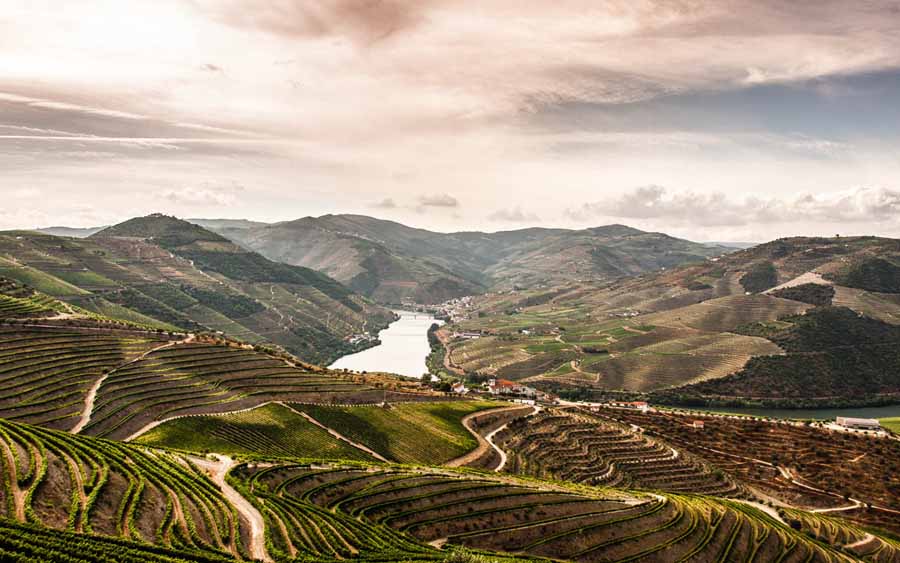
Detailed Report
Day 1, 18th October 2021. Arrival in Porto, Quinta de Aveleda wine tasting, travel to Pinhão
We began our tour with a visit to the central park in Porto. As well as many common birds this site has very recently become well known as the only location in mainland Europe to find Plain Swift, a recent colonist. Unfortunately, our visit did not coincide with them being present in the park, but this disappointment was softened by several other wonderful urban species.
Our short walk around this urban green space gave us Egyptian Goose, Mallard, Common Wood Pigeon, Common Moorhen, Eurasian Coot, Little Grebe, around 35 Yellow-legged Gulls of various ages, Great Cormorant, Eurasian Jay, Eurasian Magpie, Coal Tit, Great Tit, Common Firecrest, Goldcrest, Eurasian Wren, a briefly heard Short-toed Treecreeper, Common Blackbird, Spotted Flycatcher, European Robin, and European Pied Flycatcher.
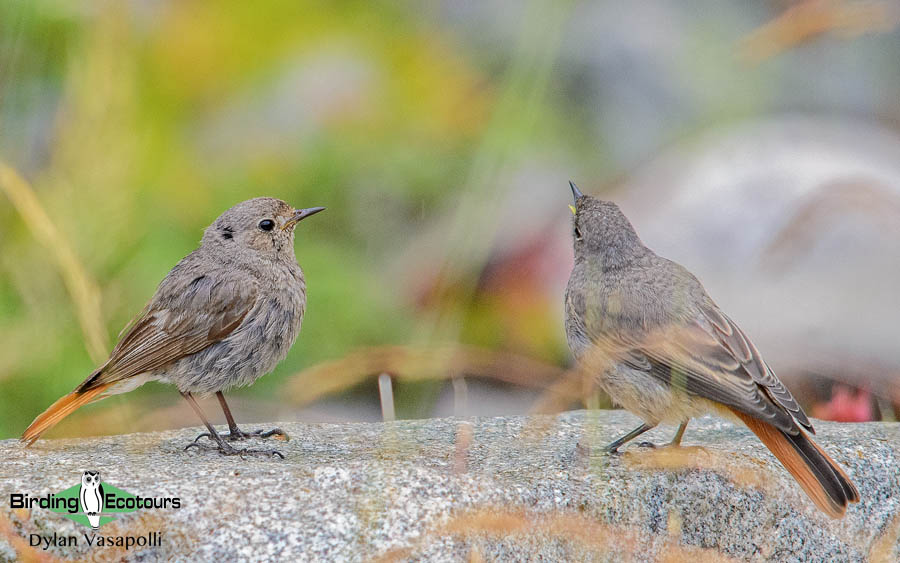
After lunch in Porto, we drove out of the city to the delightful Quinta de Aveleda vineyard, originally founded in the 17th century. This ancient vineyard specializes in the finest wines of the Douro Valley, and we enjoyed tasting their own wines and enjoyed a tour of the wine making facilities. In the beautiful gardens we managed to squeeze in some light birding around some fantastic wine tasting. Here we were able to hear the endemic Iberian Green Woodpecker, a stunning and vocal species but often elusive. We had good views of Black Redstart, brief views of Eurasian Blue Tit and Short-toed Treecreeper, heard Eurasian Nuthatch, and witnessed the interesting behavior of Spotless Starling hawking for insects over the gardens.
After our wine tasting session, we continued along the Douro Valley to our hotel near Pinhão, the beautiful Quinta de Ventozelo. During the drive to the hotel, we saw large numbers of Great Cormorant along the river, and upon arriving at the hotel we got to witness a show of around 30 White Wagtails coming to roost in the hotel grounds. A brief Blue Rock Thrush on the hotel buildings and European Greenfinch in the vineyards unfortunately did not stick around for more prolonged views, but we would have plenty of further opportunities for both during coming days.
Day 2, 19th October 2021. Birding in Douro Valley and Douro Valley wine tasting
Today we took the mountain roads east to the border with Spain as we explored the Douro Valley. However, the day started with thick and unseasonal fog. In this early gloom some of the group heard the distant song of a Eurasian Golden Oriole in the valley below. This was a very unexpected but welcome surprise, given the time of the year. Around the hotel we were able to record Sardinian Warbler, Spotless Starling, Common Blackbird, European Robin, Black Redstart, Eurasian Tree Sparrow, House Sparrow, White Wagtail, and European Goldfinch.
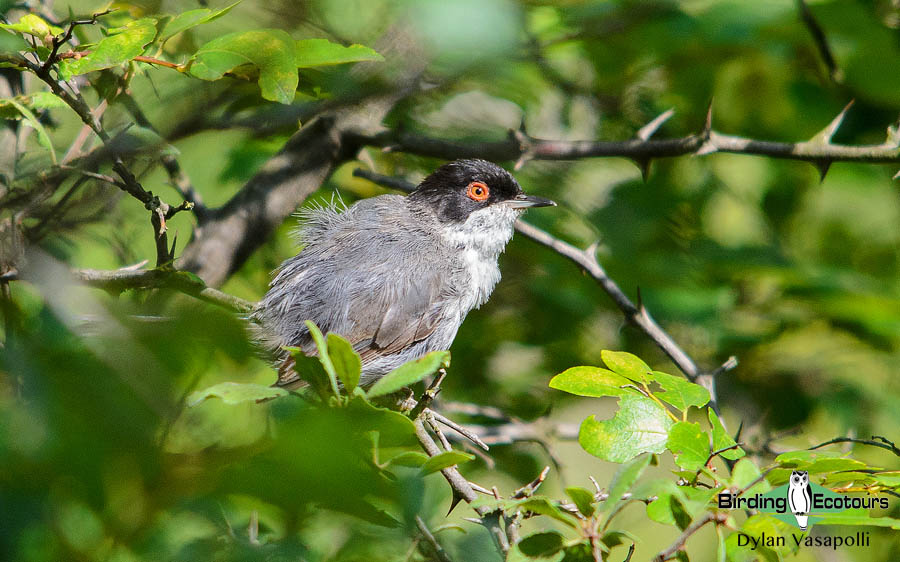
After breakfast we drove east in the gloom, with the sun slowly beginning to break through as we arrived at our first birding stop. This unassuming area in the mountains was an excellent mix of scrub habitat, rocky outcrops, and gravel tracks. It wasn’t long before we heard our first Sardinian Warbler, European Serin, European Goldfinch, and European Robin. A female European Stonechat gave brief views on overhead wires and in the distance, we got our first good look of the tour at Blue Rock Thrush, although more distant than we would have liked. By the river itself we had Eurasian Wren, another Sardinian Warbler, and over the river a Great Cormorant flew by. The highlight of this brief stop though, was a stunning Red Kite, which soared overhead and gave the whole group breathtaking views.
Returning to the van we continued along the road to a well-known spot for Black Wheatear, sadly on this occasion we could not locate them here, however further up the valley we enjoyed brief views of the beautiful Iberian Magpie, as a large flock was coming down to the river to drink before quickly moving on and out of view. Along the river valley we also saw Common Kingfisher, Common Buzzard, Black Redstart, and Common Kestrel.
Continuing our drive east we passed through the small village of Maçores. Here we found a colony of Eurasian Crag Martin, which gave excellent views. Continuing east we reached the border with Spain again and stopped for lunch at Miradouro de Penedo Durão. This incredible viewpoint enabled us to get close views of Griffon Vultures, with flight views from below and above achieved along with fantastic views of them perched on rocks in the valley below. Our only Peregrine Falcon of the tour gave a wonderful flyby while we were having lunch too, a nice bonus during our stop here.
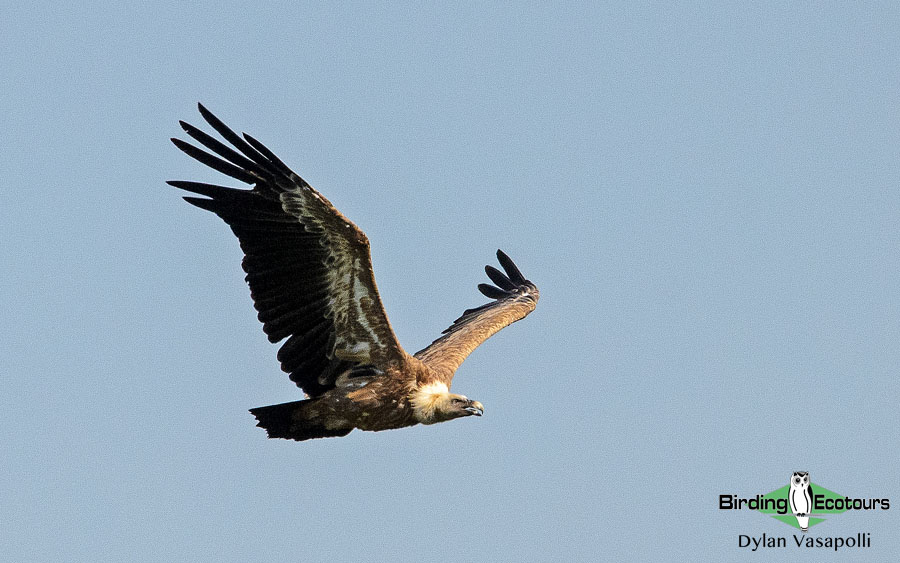
After lunch we returned through the Douro Valley to our second vineyard visit of the tour at Quinta do Vale Meao. Before reaching the vineyard, we enjoyed amazing views of Woodlark foraging in the middle of a small country road. They carried on feeding despite our van being only a few meters away. At the vineyard we explored the entire area in a Land Rover, including some land outside the border of the vineyard, and learnt a lot about the history, ecology, and geography of the area. We then sampled some fantastic wines and learnt about the wine making process here.
A few birds gave themselves up while around the vineyard with Red-legged Partridge and a singing Thekla’s Lark enjoyed by some of the group. After a long and hot day, we returned to our hotel. Along the route back we had brief views by the roadside of Red Fox and Western Barn Owl, which flashed in front of the van as we made our way through the mountains.
Day 3, 20th October 2021. Transfer Pinhão to Alvito (via Marvão)
Today was primarily set aside as a travel day from the northeast corner of Portugal to the southern regions along the Spanish border. As such there wasn’t much birding undertaken, but we did manage to squeeze some in.
A short stop at Rio Mondego-Ratoeira, a gorgeous section of river, gave us White Wagtail, Grey Wagtail, Common Waxbill, great views of three Common Buzzards, Little Grebe, Mallard, Grey Heron, Eurasian Magpie, Western Jackdaw, and Carrion Crow. Shortly before the river we again enjoyed wonderful views of Woodlark, this time in flight above the road, their beautiful song a joy for all to hear. While we watched these birds a Eurasian Sparrowhawk was seen briefly among the olive groves but disappeared quickly.
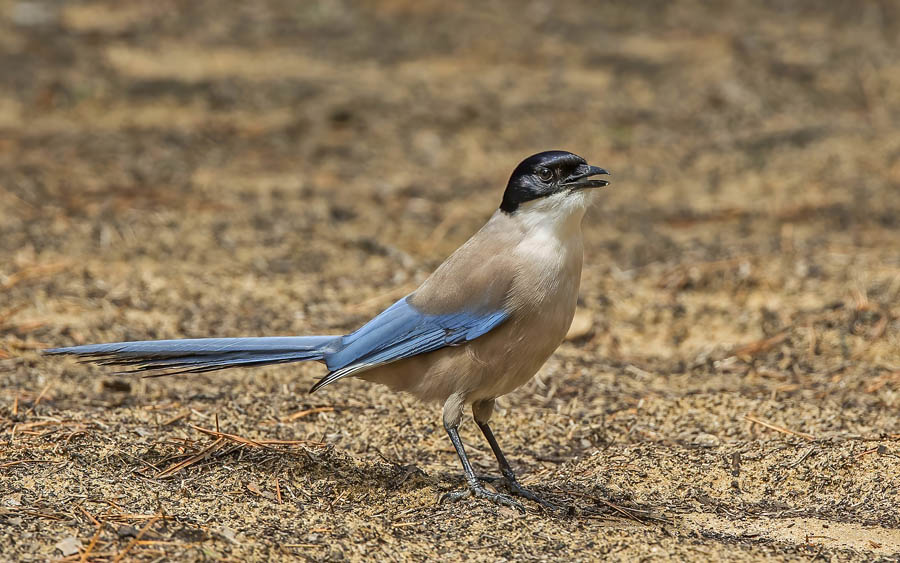
After lunch we continued south near the Spanish border, towards the ancient town of Marvão. While driving along a narrow country road our attention was taken by a couple of Iberian Magpies which flew into trees by the side of the road. We pulled over and took up a position behind a large gate and investigated the dense olive groves in front of us. This was a great decision as 24 Iberian Magpies moved through the undergrowth, giving amazing views to the entire group. The presence of flowing water attracted other species too, including Song Thrush, European Robin, and Eurasian Tree Sparrow. Nearby an Iberian Grey Shrike perched atop wires while European Stonechat and Meadow Pipit were also seen in the area.
After this incredible spectacle we continued our drive and had yet another sight to behold. Entering open grassland, we saw a couple of Griffon Vultures landing on a large rocky outcrop. It became clear that there were 36 of these magnificent birds perched on top of this outcrop, with more joining all the time. It was unclear whether there had been a carcass recently, but it was incredible to watch them sunning themselves, fighting for space, and preening.
The stunning and ancient town of Marvão gave some of the most spectacular views of the trip and gave us some quality birds too. Three more Griffon Vultures were seen over the town, while among the houses Black Redstart and Blue Rock Thrush gave prolonged views. In pine trees beside the town, we enjoyed wonderful views of a singing Cirl Bunting, our first of the tour. Also here were Common Chaffinch, Short-toed Treecreeper, Eurasian Tree Sparrow, and Eurasian Crag Martin.
As the sun was setting, we had our final spectacle of the day with a group of 19 Glossy Ibis flying over the van as we approached our hotel for the next three nights. An enjoyable end to a long day.
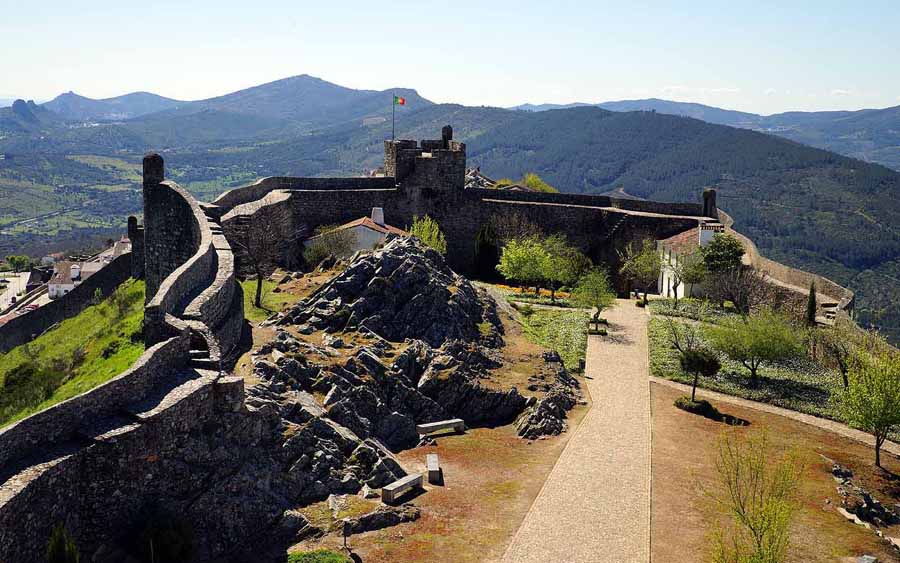
Day 4, 21st October 2021. Herdade do Esporão wine tasting and visit to Évora World Heritage Site
After yesterday’s long journey we decided to take a break today and have a late start. Even so the number of birds around our hotel was a joy to behold and we quickly managed to see Crested Lark, Black Redstart, and Common Chaffinch just outside our rooms. Also in and around the grounds were species such as Eurasian Hoopoe, Iberian Magpie, Common Raven, Common Chiffchaff, Eurasian Blue Tit, Eurasian Blackcap, Sardinian Warbler, Song Thrush, European Robin, and Corn Bunting.
After breakfast we took a short drive to the Herdade do Esporão vineyard where we enjoyed yet another excellent tour and wine tasting session. Behind the vineyard was a large lake and we observed many bird species here and in the surrounding vineyards, including Gadwall, Little Grebe, Great Crested Grebe, Northern Lapwing, Black-headed Gull, Lesser Black-backed Gull, Great Cormorant, Grey Heron, Western Cattle Egret, a flock of 35 Eurasian Spoonbill, Western Marsh Harrier, Red Kite, Common Buzzard, Eurasian Hoopoe, Iberian Grey Shrike, Eurasian Magpie, Crested Lark, and European Stonechat.
After lunch at our hotel, where we enjoyed yet more looks at Crested Lark and Black Redstart, we took a short drive to the wonderful city of Évora. Climbing through its winding streets we visited the world famous “Chapel of Bones”, a chapel with 5,000 human skulls and bones lining the walls. Continuing up we reached the Évora Roman Temple, built in the 1st century AD in honor of Emperor Augustus.
After exploring the city, and seeing Western Jackdaws above the narrow streets, we headed back to our hotel as the sun was going down and we witnessed a beautiful sunset.
Day 5, 22nd October 2021. Birding Mourão and the Spanish borderlands
After a leisurely day yesterday, it was time to resume birding and go after some big targets. Our first stop was the area around Ferrarias. This open grassland was both beautiful and interesting in equal measure and as soon as we stopped the van, we had good views of a group of seven Red-legged Partridge feeding under some trees in one of the fields. It wasn’t long before our first big target fell, as a group of five Black-bellied Sandgrouse flew past us, albeit at some distance. The exciting action continued, as shortly after two pairs of Common Crane flew over us, a really big target bird for many of the group.
We enjoyed yet another interesting observation of two Booted Eagle at middle distance over the fields in front of us, both birds were of the trickier to identify (and less often seen) dark phase. Other birds around our position here included Eurasian Hoopoe, Iberian Grey Shrike, Great Tit, Eurasian Crag Martin, Black Redstart, and Meadow Pipit.
Our next stop was a small pond by the roadside. While at first it didn’t look like much, it was soon apparent that it was teaming with waterbirds. Around the perimeter of the pond we found Egyptian Goose, Northern Lapwing, Common Ringed Plover, Common Snipe, Common Sandpiper, Spotted Redshank, Common Greenshank, Black-headed Gull, Lesser Black-backed Gull, Great Cormorant, Western Cattle Egret, and 25 Eurasian Spoonbills. The pond also attracted other species like Eurasian Magpie, Spotless Starling, Common Blackbird, European Goldfinch, and Corn Bunting. Bird of prey highlights included a stunning juvenile Hen Harrier and yet more Red Kites!
Our next stop took us briefly out of Portugal and into neighboring Spain and the region of Extremadura for a few hours. The barren steppes that lay ahead held some wonderful species. A stop by another remote pond gave us great views of a female Northern Wheatear. The pond itself held Northern Lapwing, Little Ringed Plover, Black-headed Gull, Lesser Black-backed Gull, Great Cormorant, and Grey Heron. In the adjacent fields we managed to pick up a flock of Calandra Lark, plus smaller numbers of Thekla’s Lark and Crested Lark. The best was yet to come though, as two Black-bellied Sandgrouse flew past us at close range, showing off their distinctive flight shape and beautiful coloring.
After our brief foray into Spain, it was time to return to Portugal. While driving we picked up a Great Egret at distance before reaching our next stop. As evening approached, we pulled into a farm track overlooking a vast grass field. In the distance the sound of Common Crane could be heard, and it wasn’t long before 60 birds came down to roost on the hillside, giving lovely views in the evening sun. Shortly after, we were able to enjoy wonderful views of four Black-winged Kite. Despite being distant we had good views of them hunting as the sun set. Also present here were Northern Lapwing, Common Kestrel, Iberian Grey Shrike, Eurasian Skylark (singing distantly), Crested Lark, White Wagtail, Meadow Pipit, and Corn Bunting.
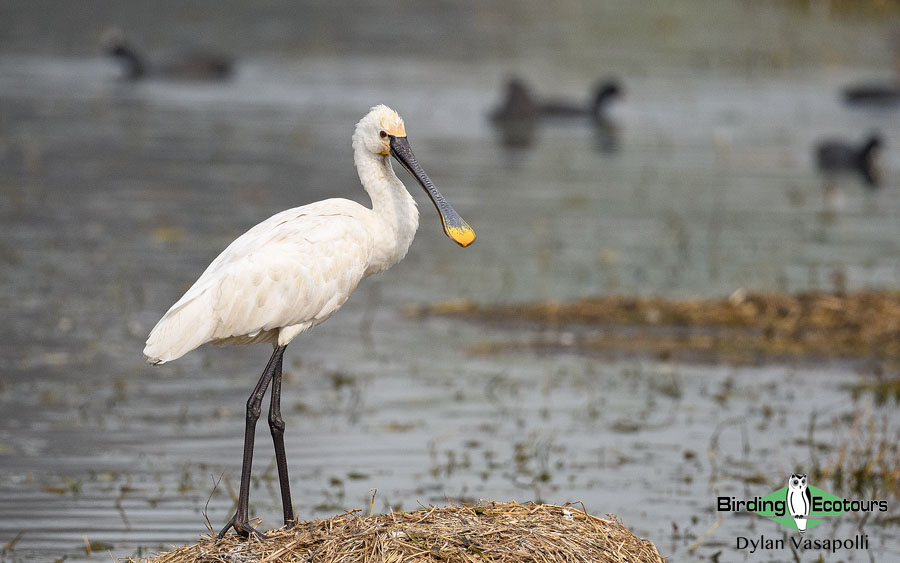
Day 6, 23rd October 2021. Birding at Castro Verde, transfer to Algarve
Today we headed south through central Portugal, further exploring the vast open plains of the interior of the country. The heat of the day quickly made looking at distance particularly challenging as we searched for the special species of this area. However, our first stop did reveal a group of twelve Eurasian Stone-curlews, which gave prolonged views. Raptors were also present here with Western Marsh Harrier, numerous Red Kites, and Common Buzzard all recorded, often closely followed by opportunistic Carrion Crows ready to scavenge any leftovers!
Moving on, we checked another area of plains. Here we were very lucky to find four Lesser Kestrel, a late-in-the-season record for this species in Portugal. These were joined by two Eurasian Sparrowhawk, one of which gave stunning views. Far in the distance a small group of Common Crane were present and yet more Red Kites and Common Buzzards patrolled the sky.
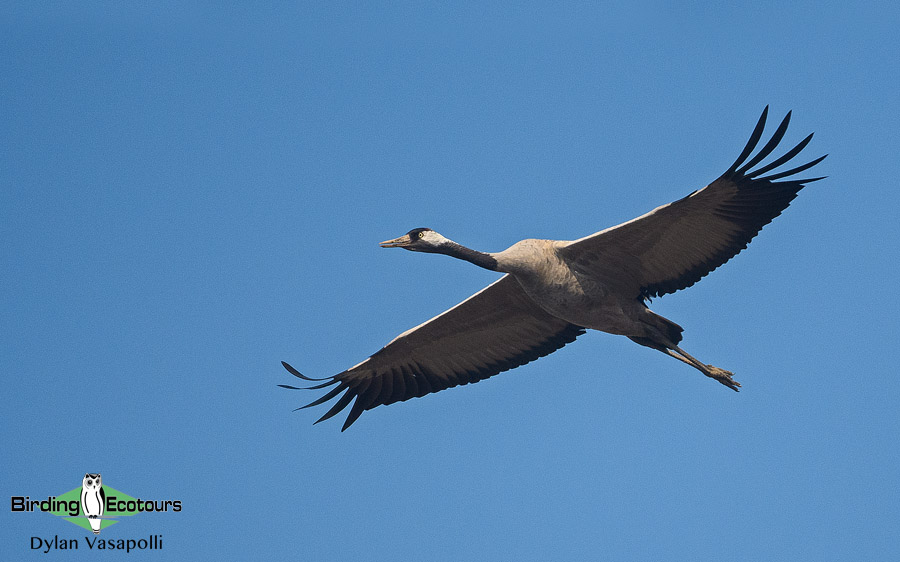
For lunch we decided to visit a hermitage high up on a hill which overlooked the plains. The shade here made for a fantastic spot to escape the heat of the day. After packing our lunch away, we made our way back down the large hill, where shortly after a simply incredible 20-minutes of birding ensued. First, from a field close to the track, a breathtaking flock of eleven Great Bustards took flight, disappearing behind farm buildings close by. The shock of seeing these rare birds so well was soon increased as they appeared again on a nearby mound and gave outstanding prolonged views, a real big target for the whole group was successfully secured! As we watched the bustards, another Northern Wheatear performed well, as did an Iberian Grey Shrike. As the last of the bustards disappeared behind a hill a stunning male Hen Harrier cruised over the field close to our van, giving wonderful views of its ghostly figure.
We decided to change position to see if we could relocate the bustards, but sadly we could not. However, far off in the distance, a familiar shape to our guides soared over the plains below. After a quick double check the call came out, Spanish Imperial Eagle! A small amount of chaos ensued as we tried to get the whole group onto this rare and mystical bird, one by one the group took turns to look through the scope which was locked onto the bird as it soared higher and higher, eventually being lost to view. A truly special moment and a bird that was certainly not on the expected list before the tour began due to the low numbers of this rare species in Portugal.
After these thrilling whirlwind moments it was time to head south to the Algarve. After a long journey we arrived at our hotel on the edge of the Ria Formosa Natural Park. On the approach road we were able to pick out a few waterbirds and shorebirds including Greater Flamingo, Black-winged Stilt, Black-headed Gull, Grey Heron, Little Egret, and Eurasian Spoonbill.
Day 7, 24th October 2021. Birding Ria Formosa Natural Park and Lagoa de Aldeia Nova
Today we started with a wonderful boat trip around the Ria Formosa Natural Park and its many islands. This proved to be a festival of shorebirds and waterbirds, with many species seen and great views had by all. We also learnt some fascinating information about the park, its ecology, and the species that use the area. Shorebirds were in large supply and included Eurasian Oystercatcher, Grey Plover, Common Ringed Plover, Eurasian Whimbrel, Eurasian Curlew, Bar-tailed Godwit, Black-tailed Godwit, Ruddy Turnstone, Red Knot, Sanderling, Dunlin, Common Sandpiper, and Common Redshank. Gulls and terns were also present in good numbers with excellent views of Slender-billed Gull and Mediterranean Gull the highlights, along with Black-headed Gull, Yellow-legged Gull, Lesser Black-backed Gull, and Sandwich Tern all seen too.
The islets around the site were dotted with waterbirds like White Stork, Great Cormorant, Grey Heron, Little Egret, and Eurasian Spoonbill. We also enjoyed the wonderful sight of a large group of Greater Flamingos flying along the coast. Despite the distance their pink sheen was still clear to see. A Western Osprey also put on a fantastic show towards the end of our boat tour.
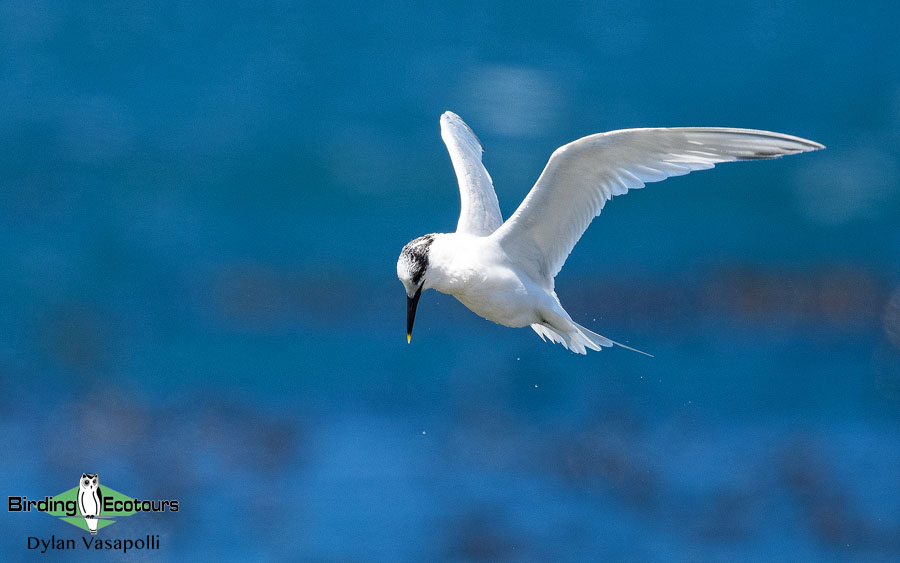
After a delicious lunch in Olhão we headed to the nearby Lagoa de Aldeia Nova. This small lagoon, surrounded by Stone Pine woodland, once present along the whole of the Algarve, was teeming with life and gave us some awesome birding moments. Shortly after entering the woodland the distinctive call of European Crested Tit was heard, allowing good views for the group. Also in the woodland we came across Short-toed Treecreeper, three Common Chiffchaffs, Iberian Magpie, Common Wood Pigeon, Eurasian Jay, Common Blackbird, and Common Waxbill.
We then decided to walk around the lagoon to look for more waterbirds. The highlight here was four immaculate Ferruginous Ducks, a species in significant decline across its European range. Joining these highly sought-after ducks on the lagoon were Mallard, Common Pochard, Common Moorhen, Eurasian Coot, and a raft of Yellow-legged Gulls and Lesser Black-backed Gulls of varying ages. Overhead we enjoyed brief views of a glorious adult Audouin’s Gull. Also over the pool was a solitary Barn Swallow and a small number of Eurasian Crag Martins.
With the sun getting lower in the sky, we retreated towards our hotel. A brief stop at the saltpans near the hotel gave a wonderful spectacle of around 200 Greater Flamingos feeding on one of the pans. These were joined by Sanderling, Mediterranean Gull, Yellow-legged Gull, Eurasian Magpie, European Stonechat, and our first Spanish Sparrow of the tour.
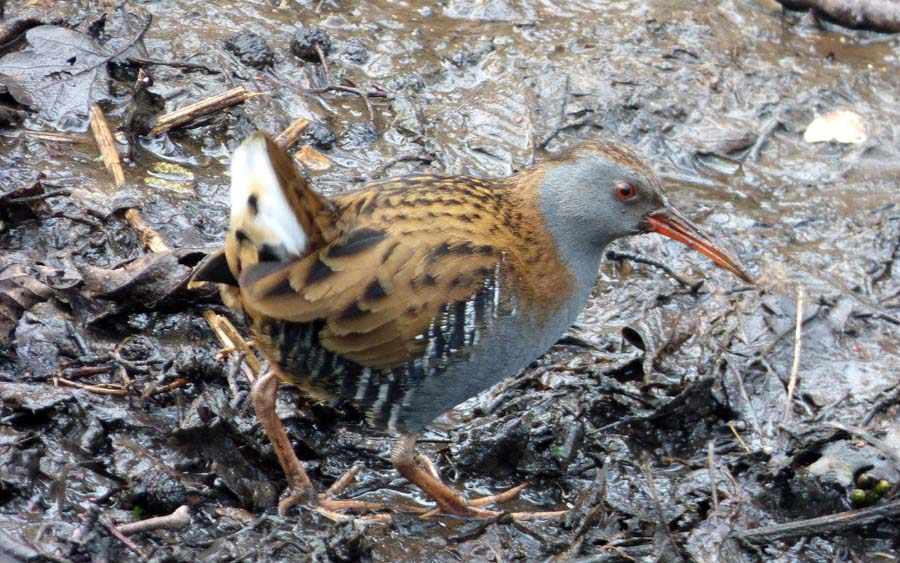
Day 8, 25th October 2021. Birding Ria de Alvor, Sagres, and Cape St Vincent, with Monte da Casteleja wine tasting
Today we explored more of the Algarve and its beautiful coastline. Our first stop was the wetlands around the Ria de Alvor, the nearby estuary forming at the confluence of three rivers. Before reaching the site, we had wonderful views of Eurasian Hoopoe, which fed close to the van as we watched on, it is always a treat to see this highly desired species.
Upon reaching the site we walked along a raised bank, which gave us a good vantage point to spot some of the interesting species of the area. Scanning from here gave us some of the more common species such as Mallard, Common Redshank, Black-headed Gull, Yellow-legged Gull, Great Cormorant, Grey Heron, Eurasian Spoonbill, and Crested Lark.
Some dense vegetation close to the path proved fruitful, with first a couple of Common Chiffchaff moving through, then the skulking shape of a stunning Water Rail hopped across a small gap in the vegetation. This was then joined by a second bird and after some patient waiting, we enjoyed wonderful views of this often-shy species. This area continued to be rewarding as we got to enjoy brief but excellent views of a Bluethroat, another highly prized and often cryptic species.
After a quick scan of the nearby fields and trees, which gave us Meadow Pipit, European Stonechat, European Robin, Sardinian Warbler, and a flyover Iberian Magpie, we left the site to head to our next wine tasting experience at Monte da Casteleja.
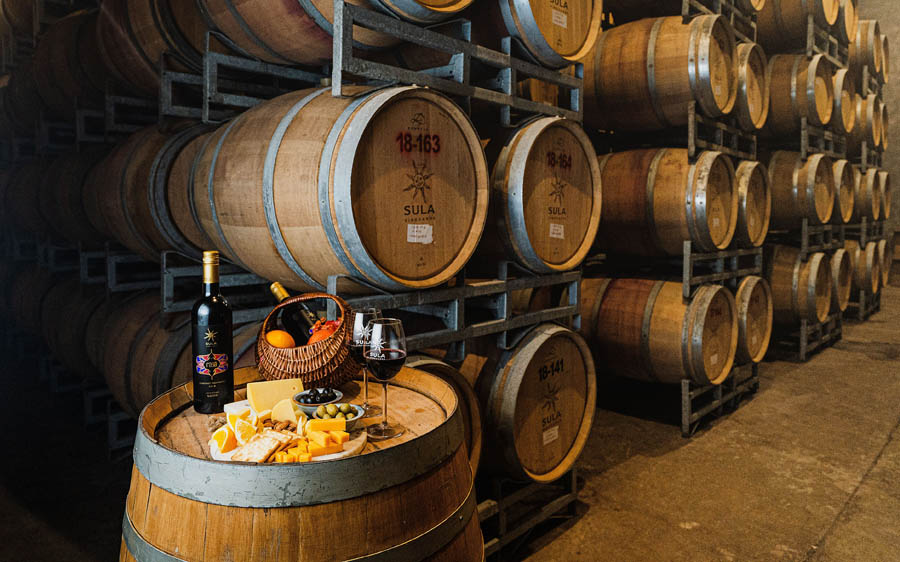
Monte da Casteleja is a small, organic vineyard and has been owned by the same family since 1952, being originally started by the current owner’s grandfather. Wine production only commenced here in 2004, making the vineyard’s rise into a unique organic experience more impressive. Here we enjoyed lovely wines under the shade of a large veranda and enjoyed a tour of the impressive site and wine making facilities.
After leaving the vineyard we continued west to the extreme southwest point of Portugal, around the town of Sagres. Our first stop was the raptor watchpoint, a high area where raptor counts are undertaken every year during the migration. Our approach to the site was greeted with the amazing view of around 400 Griffon Vultures circling at distance. Despite the distance their huge size was apparent, and we watched the flock move up and down the coast, waiting for an opportune moment to cross the Atlantic towards Africa (next stop Morocco).
At the raptor site itself we once again enjoyed views of the Griffon Vultures, plus other birds of prey including four Booted Eagles, multiple Red Kites and Common Buzzards, and a single fly through by Eurasian Hobby, a pleasant surprise that caught all of us off guard! Around the site a flock of Eurasian Linnets kept us entertained, as did another stunning Northern Wheatear. The final birds here were a beautiful Black Stork, which gave prolonged views as it circled over the watchpoint and a flock of 35 European Golden Plovers which flew over the site just before we departed.
With the afternoon pressing on we decided to head down to Cape St Vincent to see what birds lurked around the cliffs and over the sea. The battering winds here, a favorite for surfers, made birding very challenging. However, we did score a few interesting species, with Yellow-legged Gull, Northern Gannet, Eurasian Crag Martin, and Sardinian Warbler all present. Overhead an adult female Hen Harrier soared over, and brief views were had of a Cory’s Shearwater moving low over the sea. For the first time on the tour the weather got the better of us, and we retreated to the van, making the journey back to our hotel.
Day 9, 26th October 2021. Birding Lagoa dos Salgados, transfer to Lisbon, Casa Ermelinda Freitas wine tasting
Today it was time to leave the Algarve and make our way towards our destination of Lisbon. Before leaving the area, we visited the wonderful Lagoa dos Salgados. This site is one of the most important freshwater lagoons on the Algarve and the number of birds here paid testament to that.
Upon arrival we had excellent views once again of a stunning Northern Wheatear, fast becoming a firm favorite of the tour, and as we walked towards the pool, we got to enjoy the marvel of several hundred Glossy Ibis coming to feed, their distinctive shape clear to see as they tumbled from the sky in typical fashion.
Reaching a small blind (bird hide) next to the pool gave us the perfect position from which to scan the vast body of water. The number of waterbirds and shorebirds on view was remarkable and we got to enjoy many of the species we had seen previously and new species such as Northern Pintail, Western Swamphen (which sadly showed all too briefly), Pied Avocet, and Ruff. We also had great views of Common Kingfisher, Eurasian Teal, Booted Eagle, and Zitting Cisticola.
The highlight species for the group was a stunning Iberian Grey Shrike which posed perfectly for a prolonged period, giving wonderful views of its striking plumage. In total we recorded 49 species around the lagoon in just 90-minutes, a good return, and an excellent location for easy birding.
With the temperature starting to climb we made our way back to the van, reflecting on a great morning of birding. We would now make the drive across Portugal to Lisbon, a stunning drive through mountains, grasslands, Stone Pine forest, and agricultural areas. Along the route we stopped for lunch in the plains town of Castro Verde, where we had been just a few days previously. Opposite the restaurant was a gorgeous wall painting of a Great Bustard, a symbol of the importance of this species to this region of Portugal.
Before we reached Lisbon, we stopped for our final wine tasting of the trip at Adega de Catapereiro. This vineyard is part of a state owned cooperative and an integral part of the local ecosystem. One of their signature wines is called “Tyto Alba”, the scientific name for Western Barn Owl, and we enjoyed this and other wines in the beautiful vineyard shop following a guided tour by the chief wine maker, another thoroughly enjoyable experience.
After a long day we arrived at our final hotel on the outskirts of Lisbon. Here we would meet Domingos, Executive Director of SPEA, who would be with us for the final day of the tour.
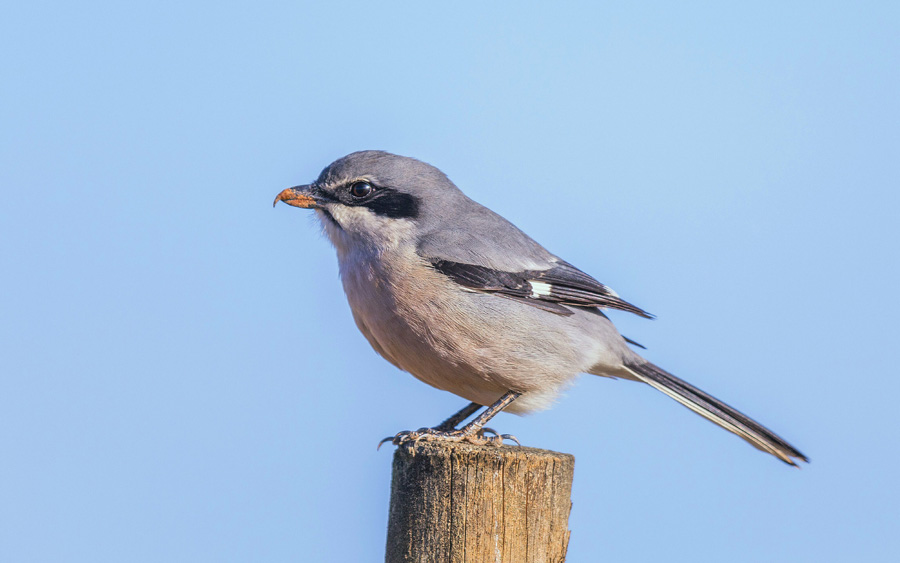
Day 10, 27th October 2021. Birding Tagus Estuary, Fado dancing in the evening
Our final full day in Portugal would see us explore part of the massive Tagus Estuary near Lisbon. The area we focused on is known as Leziria Grande de Vila Franca de Xira, a vast area of rice fields, dry grasslands, tidal floodplain, ditches, and wetlands.
We enjoyed a wonderful few hours in this wetland with large number of species seen. Along the main entrance road, we made periodic stops to investigate the many irrigation channels that crisscrossed the land. Here we observed species such as Green Sandpiper, Common Kingfisher, and Black-winged Kite, plus some interesting introduced species like Yellow-crowned Bishop and Scaly-breasted Munia. Further along the entrance road we stopped to scan for Little Bustard, a species which winters in the area. Sadly, we didn’t find any of this nationally declining species on this occasion but did find two small groups of European Golden Plover, which gave prolonged views at close range.
Continuing through the vast field systems we eventually reached Ponta d’Erva, a small corner of land on the edge of the Sorraia River. From here we scanned the mud banks on both sides of the water for shorebirds and waterbirds. Highlights here included Common Shelduck, Pied Avocet, Common Snipe, Eurasian Spoonbill, and a whole host of other shorebirds, including Northern Lapwing, Common Ringed Plover, Black-tailed Godwit, and Common Sandpiper. In a small creek next to our position, we also got to enjoy prolonged views of a stunning Bluethroat, including seeing it pull a large worm from the mud in a truly fascinating piece of behavior.
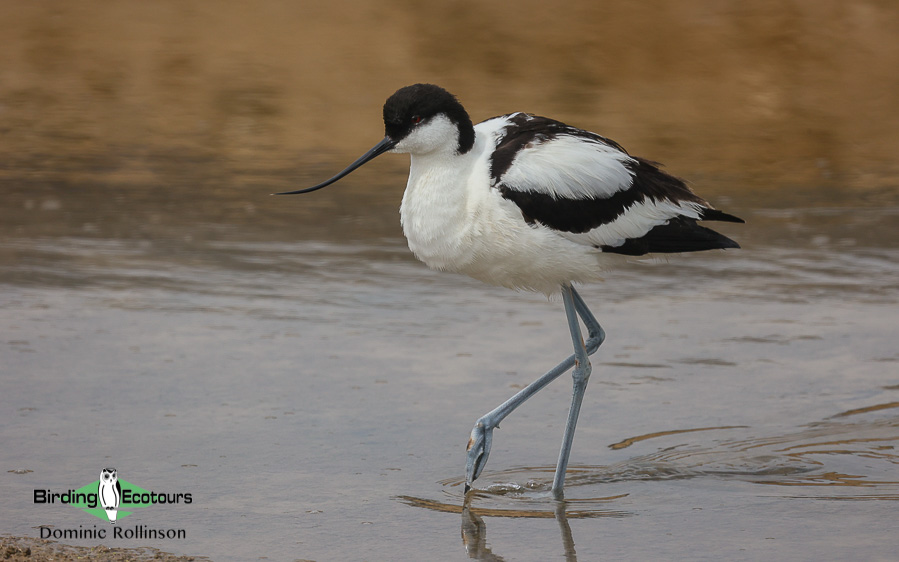
Moving on we headed back into the agricultural areas towards the only real landmark in this open expanse, the stunning Ermida de Nossa Senhora de Alcamé. This attractive church was built for the farm workers of the area and stands proud above the flat scenery surrounding it. Here we would have a picnic lunch in the shade of the church as the day grew hotter. While lunch was generally quiet bird wise things changed as we were leaving. Soaring above us was a stunning pair of Bonelli’s Eagle, a real star bird for the trip. We watched the pair until they moved away and out of view, a truly memorable experience with this magnificent raptor.
After lunch we began the route out of the site. Along the way we enjoyed excellent close views of a female Hen Harrier hunting over the rice fields, more Black-winged Kites, and the stunning sight of around 1,500 Greater Flamingos and White Storks feeding in fields adjacent to the track, a truly magnificent spectacle.
Our final birding stop of the tour would be on the south side of the Tagus Estuary, close to our hotel. Here we scanned the mudflats and enjoyed many of the shorebirds we had previously seen. The highlight species here were two Western Ospreys interacting over the vast mudflats and a stunning Caspian Tern sat close to shore on the mud, our final new bird of the tour.
Shortly after this we said our goodbyes to Sandra, who was taking an early flight the following morning, and the remaining members of the group enjoyed a final meal accompanied by traditional Portuguese Fado dancing, a fantastic way to end a magnificent tour of Portugal. Thank you all!
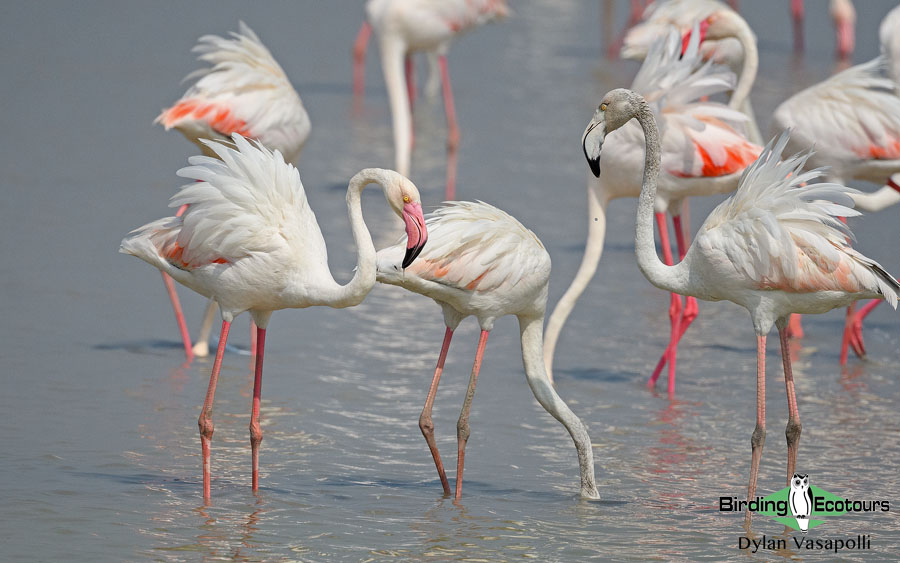
Bird List – Following IOC (11.2)
Birds ‘heard only’ are marked with (H) after the common name, all other species were seen.
The following notation after species names is used to show conservation status following BirdLife International: VU = Vulnerable.
| Common Name | Scientific Name |
| Ducks, Geese, Swans (Anatidae) | |
| Greylag Goose | Anser anser |
| Egyptian Goose | Alopochen aegyptiaca |
| Common Shelduck | Tadorna tadorna |
| Northern Shoveler | Spatula clypeata |
| Gadwall | Mareca strepera |
| Mallard | Anas platyrhynchos |
| Northern Pintail | Anas acuta |
| Eurasian Teal | Anas crecca |
| Common Pochard – VU | Aythya ferina |
| Ferruginous Duck | Aythya nyroca |
| Pheasants & Allies (Phasianidae) | |
| Red-legged Partridge | Alectoris rufa |
| Bustards (Otididae) | |
| Great Bustard – VU | Otis tarda |
| Sandgrouse (Pteroclidae) | |
| Black-bellied Sandgrouse | Pterocles orientalis |
| Pigeons, Doves (Columbidae) | |
| Rock Dove | Columba livia |
| Common Wood Pigeon | Columba palumbus |
| Eurasian Collared Dove | Streptopelia decaocto |
| Rails, Crakes & Coots (Rallidae) | |
| Water Rail | Rallus aquaticus |
| Common Moorhen | Gallinula chloropus |
| Eurasian Coot | Fulica atra |
| Western Swamphen | Porphyrio porphyrio |
| Cranes (Gruidae) | |
| Common Crane | Grus grus |
| Grebes (Podicipedidae) | |
| Little Grebe | Tachybaptus ruficollis |
| Great Crested Grebe | Podiceps cristatus |
| Flamingos (Phoenicopteridae) | |
| Greater Flamingo | Phoenicopterus roseus |
| Stone-curlews, Thick-knees (Burhinidae) | |
| Eurasian Stone-curlew | Burhinus oedicnemus |
| Oystercatchers (Haematopodidae) | |
| Eurasian Oystercatcher | Haematopus ostralegus |
| Stilts, Avocets (Recurvirostridae) | |
| Black-winged Stilt | Himantopus himantopus |
| Pied Avocet | Recurvirostra avosetta |
| Plovers (Charadriidae) | |
| Northern Lapwing | Vanellus vanellus |
| European Golden Plover | Pluvialis apricaria |
| Grey Plover | Pluvialis squatarola |
| Common Ringed Plover | Charadrius hiaticula |
| Little Ringed Plover | Charadrius dubius |
| Sandpipers, Snipes (Scolopacidae) | |
| Eurasian Whimbrel | Numenius phaeopus |
| Eurasian Curlew | Numenius arquata |
| Bar-tailed Godwit | Limosa lapponica |
| Black-tailed Godwit | Limosa limosa |
| Ruddy Turnstone | Arenaria interpres |
| Red Knot | Calidris canutus |
| Ruff | Calidris pugnax |
| Sanderling | Calidris alba |
| Dunlin | Calidris alpina |
| Common Snipe | Gallinago gallinago |
| Common Sandpiper | Actitis hypoleucos |
| Green Sandpiper | Tringa ochropus |
| Common Redshank | Tringa totanus |
| Spotted Redshank | Tringa erythropus |
| Common Greenshank | Tringa nebularia |
| Gulls, Terns, Skimmers (Laridae) | |
| Slender-billed Gull | Chroicocephalus genei |
| Black-headed Gull | Chroicocephalus ridibundus |
| Audouin’s Gull – VU | Ichthyaetus audouinii |
| Mediterranean Gull | Ichthyaetus melanocephalus |
| Yellow-legged Gull | Larus michahellis |
| Lesser Black-backed Gull | Larus fuscus |
| Caspian Tern | Hydroprogne caspia |
| Sandwich Tern | Thalasseus sandvicensis |
| Petrels, Shearwaters, Diving Petrels (Procellariidae) | |
| Cory’s Shearwater | Calonectris borealis |
| Storks (Ciconiidae) | |
| Black Stork | Ciconia nigra |
| White Stork | Ciconia ciconia |
| Gannets, Boobies (Sulidae) | |
| Northern Gannet | Morus bassanus |
| Cormorants, Shags (Phalacrocoracidae) | |
| Great Cormorant | Phalacrocorax carbo |
| Ibises, Spoonbills (Threskiornithidae) | |
| Glossy Ibis | Plegadis falcinellus |
| Eurasian Spoonbill | Platalea leucorodia |
| Herons, Bitterns (Ardeidae) | |
| Western Cattle Egret | Bubulcus ibis |
| Grey Heron | Ardea cinerea |
| Great Egret | Ardea alba |
| Little Egret | Egretta garzetta |
| Ospreys (Pandionidae) | |
| Western Osprey | Pandion haliaetus |
| Kites, Hawks, Eagles (Accipitridae) | |
| Black-winged Kite | Elanus caeruleus |
| European Honey Buzzard | Pernis apivorus |
| Griffon Vulture | Gyps fulvus |
| Booted Eagle | Hieraaetus pennatus |
| Spanish Imperial Eagle – VU | Aquila adalberti |
| Bonelli’s Eagle | Aquila fasciata |
| Eurasian Sparrowhawk | Accipiter nisus |
| Western Marsh Harrier | Circus aeruginosus |
| Hen Harrier | Circus cyaneus |
| Red Kite | Milvus milvus |
| Common Buzzard | Buteo buteo |
| Barn Owls (Tytonidae) | |
| Western Barn Owl | Tyto alba |
| Hoopoes (Upupidae) | |
| Eurasian Hoopoe | Upupa epops |
| Kingfishers (Alcedinidae) | |
| Common Kingfisher | Alcedo atthis |
| Woodpeckers (Picidae) | |
| Iberian Green Woodpecker (H) | Picus sharpei |
| Caracaras, Falcons (Falconidae) | |
| Lesser Kestrel | Falco naumanni |
| Common Kestrel | Falco tinnunculus |
| Eurasian Hobby | Falco subbuteo |
| Peregrine Falcon | Falco peregrinus |
| African & New World Parrots (Psittacidae) | |
| Monk Parakeet | Myiopsitta monachus |
| Shrikes (Laniidae) | |
| Iberian Grey Shrike | Lanius meridionalis |
| Figbirds, Orioles, Turnagra (Oriolidae) | |
| Eurasian Golden Oriole (H) | Oriolus oriolus |
| Crows, Jays (Corvidae) | |
| Eurasian Jay | Garrulus glandarius |
| Iberian Magpie | Cyanopica cooki |
| Eurasian Magpie | Pica pica |
| Western Jackdaw | Coloeus monedula |
| Carrion Crow | Corvus corone |
| Northern Raven | Corvus corax |
| Tits, Chickadees (Paridae) | |
| Coal Tit | Periparus ater |
| European Crested Tit | Lophophanes cristatus |
| Eurasian Blue Tit | Cyanistes caeruleus |
| Great Tit | Parus major |
| Larks (Alaudidae) | |
| Woodlark | Lullula arborea |
| Eurasian Skylark | Alauda arvensis |
| Thekla’s Lark | Galerida theklae |
| Crested Lark | Galerida cristata |
| Calandra Lark | Melanocorypha calandra |
| Swallows, Martins (Hirundinidae) | |
| Eurasian Crag Martin | Ptyonoprogne rupestris |
| Barn Swallow | Hirundo rustica |
| Cettia Bush Warblers & Allies (Cettiidae) | |
| Cetti’s Warbler (H) | Cettia cetti |
| Leaf Warblers & Allies (Phylloscopidae) | |
| Common Chiffchaff | Phylloscopus collybita |
| Cisticolas & Allies (Cisticolidae) | |
| Zitting Cisticola | Cisticola juncidis |
| Sylviid Babblers (Sylviidae) | |
| Eurasian Blackcap | Sylvia atricapilla |
| Sardinian Warbler | Curruca melanocephala |
| Goldcrests, Kinglets (Regulidae) | |
| Common Firecrest | Regulus ignicapilla |
| Goldcrest | Regulus regulus |
| Wrens (Troglodytidae) | |
| Eurasian Wren | Troglodytes troglodytes |
| Nuthatches (Sittidae) | |
| Eurasian Nuthatch | Sitta europaea |
| Treecreepers (Certhiidae) | |
| Short-toed Treecreeper | Certhia brachydactyla |
| Starlings, Rhabdornis (Sturnidae) | |
| Spotless Starling | Sturnus unicolor |
| Thrushes (Turdidae) | |
| Song Thrush | Turdus philomelos |
| Common Blackbird | Turdus merula |
| Chats, Old World Flycatchers (Muscicapidae) | |
| Spotted Flycatcher | Muscicapa striata |
| European Robin | Erithacus rubecula |
| Bluethroat | Luscinia svecica |
| European Pied Flycatcher | Ficedula hypoleuca |
| Black Redstart | Phoenicurus ochruros |
| Blue Rock Thrush | Monticola solitarius |
| European Stonechat | Saxicola rubicola |
| Northern Wheatear | Oenanthe oenanthe |
| Old World Sparrows, Snowfinches (Passeridae) | |
| Eurasian Tree Sparrow | Passer montanus |
| Spanish Sparrow | Passer hispaniolensis |
| House Sparrow | Passer domesticus |
| Weavers, Widowbirds (Ploceidae) | |
| Yellow-crowned Bishop | Euplectes afer |
| Waxbills, Munias & Allies (Estrildidae) | |
| Scaly-breasted Munia | Lonchura punctulata |
| Common Waxbill | Estrilda astrild |
| Wagtails, Pipits (Motacillidae) | |
| Western Yellow Wagtail | Motacilla flava |
| Grey Wagtail | Motacilla cinerea |
| White Wagtail | Motacilla alba |
| Meadow Pipit | Anthus pratensis |
| Finches, Euphonias (Fringillidae) | |
| Common Chaffinch | Fringilla coelebs |
| European Greenfinch | Chloris chloris |
| Common Linnet | Linaria cannabina |
| European Goldfinch | Carduelis carduelis |
| European Serin | Serinus serinus |
| Buntings (Emberizidae) | |
| Corn Bunting | Emberiza calandra |
| Cirl Bunting | Emberiza cirlus |
| Total seen | 142 |
| Total heard only | 3 |
| Total recorded | 145 |
Mammal List
| Common Name | Scientific Name |
| Dogs (Canidae) | |
| Red Fox | Vulpes vulpes |
| Rabbits and Hares (Leporidae) | |
| European Rabbit | Oryctolagus cuniculus |
| Granada (Iberian) Hare | Lepus granatensis |
| Total | 3 |
Reptile List
| Common Name | Scientific Name |
| Pond Turtles (Emydidae) | |
| European Pond Turtle | Emys orbicularis |
| Total | 1 |
Crustacean List
| Common Name | Scientific Name |
| Semiterrestrial Crabs (Ocypodidae) | |
| European Fiddler Crab | Afruca tangeri |
| Total | 1 |
Please see the downloadable PDF above with the full species lists included. This is a sample trip report. Please email us ([email protected]) for more trip reports from this destination.
